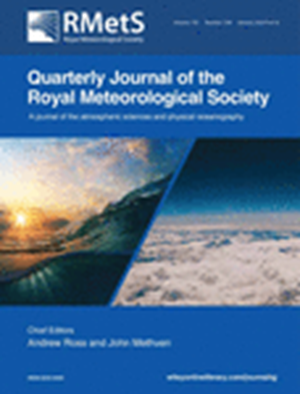Multivariate post‐processing of probabilistic sub‐seasonal weather regime forecasts
IF 2.9
3区 地球科学
Q2 METEOROLOGY & ATMOSPHERIC SCIENCES
引用次数: 0
Abstract
Reliable forecasts of quasi‐stationary, recurrent, and persistent large‐scale atmospheric circulation patterns—so‐called weather regimes—are crucial for various socio‐economic sectors, including energy, health, and agriculture. Despite steady progress, probabilistic weather regime predictions still exhibit biases in the exact timing and amplitude of weather regimes. This study thus aims at advancing probabilistic weather regime predictions in the North Atlantic–European region through ensemble post‐processing. Here, we focus on the representation of seven year‐round weather regimes in sub‐seasonal to seasonal reforecasts of the European Centre for Medium‐Range Weather Forecasts (ECMWF). The manifestation of each of the seven regimes can be expressed by a continuous weather regime index, representing the projection of the instantaneous 500‐hPa geopotential height anomalies (A) onto the respective mean regime pattern. We apply a two‐step ensemble post‐processing involving first univariate ensemble model output statistics and second ensemble copula coupling, which restores the multivariate dependence structure. Compared with current forecast calibration practices, which rely on correcting the field by the lead‐time‐dependent mean bias, our approach extends the forecast skill horizon for daily/instantaneous regime forecasts moderately by 1 day (from 13.5 to 14.5 days). Additionally, to our knowledge our study is the first to evaluate the multivariate aspects of forecast quality systematically for weather regime forecasts. Our method outperforms current practices in the multivariate aspect, as measured by the energy and variogram score. Still, our study shows that, even with advanced post‐processing, weather regime prediction becomes difficult beyond 14 days, which likely points towards intrinsic limits of predictability for daily/instantaneous regime forecasts. The proposed method can easily be applied to operational weather regime forecasts, offering a neat alternative for cost‐ and time‐efficient post‐processing of real‐time weather regime forecasts.对概率性分季节天气预报进行多元后处理
准静止、反复和持续的大尺度大气环流模式--即所谓的天气机制--的可靠预报对能源、健康和农业等各社会经济部门至关重要。尽管取得了稳步进展,但概率天气机制预测在天气机制的确切时间和振幅方面仍存在偏差。因此,本研究旨在通过集合后处理推进北大西洋-欧洲地区的概率天气机制预测。在此,我们重点研究欧洲中期天气预报中心(ECMWF)的分季节到季节性再预测中对七种全年天气变化的表示。这七种天气形势的表现可以用连续的天气形势指数来表示,它代表了瞬时 500 hPa 位势高度异常(A)对相应平均天气形势模式的投影。我们采用了两步集合后处理方法,第一步是单变量集合模式输出统计,第二步是恢复多变量依赖结构的集合共轭耦合。目前的预报校准方法是通过前导时间相关平均偏差来校正场,与之相比,我们的方法将每日/瞬时季节预报的预报技能范围适度延长了 1 天(从 13.5 天延长到 14.5 天)。此外,据我们所知,我们的研究是首次对天气预报质量的多变量方面进行系统评估。我们的方法在多变量方面优于目前的做法,这是以能量和变异图得分来衡量的。不过,我们的研究表明,即使进行了先进的后处理,天气变化预测也很难超过 14 天,这可能表明每日/瞬时天气变化预测的可预测性存在内在限制。所提出的方法可轻松应用于业务天气预报,为实时天气预报的成本和时间效率后处理提供了一种简便的替代方法。
本文章由计算机程序翻译,如有差异,请以英文原文为准。
求助全文
约1分钟内获得全文
求助全文
来源期刊
CiteScore
16.80
自引率
4.50%
发文量
163
审稿时长
3-8 weeks
期刊介绍:
The Quarterly Journal of the Royal Meteorological Society is a journal published by the Royal Meteorological Society. It aims to communicate and document new research in the atmospheric sciences and related fields. The journal is considered one of the leading publications in meteorology worldwide. It accepts articles, comprehensive review articles, and comments on published papers. It is published eight times a year, with additional special issues.
The Quarterly Journal has a wide readership of scientists in the atmospheric and related fields. It is indexed and abstracted in various databases, including Advanced Polymers Abstracts, Agricultural Engineering Abstracts, CAB Abstracts, CABDirect, COMPENDEX, CSA Civil Engineering Abstracts, Earthquake Engineering Abstracts, Engineered Materials Abstracts, Science Citation Index, SCOPUS, Web of Science, and more.

 求助内容:
求助内容: 应助结果提醒方式:
应助结果提醒方式:


